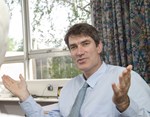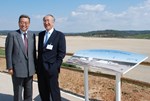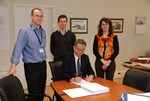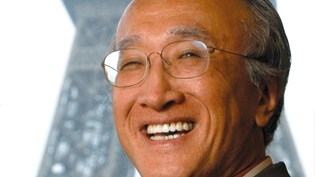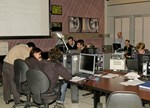ITER NEWSLINE
126
|
Steven Cowley directs the Culham Centre for Fusion Energy, CCFE, UK's leading fusion research centre. In a recent presentation on TED, a renowned online think-tank in the US, he stated that nuclear fusion is the only truly sustainable solution to the fuel crisis. In this week's issue of Newsline we ask the prominent physicist what remains to be done on the way to commercial fusion energy.
In last week's Newsline we mentioned that MAST, the UK's sperical tokamak, received £30 million for its upgrade. So you must be a happy man, I guess?
Yes indeed, we are very happy about the upgrade of MAST, which will allow us to test some of the things that ITER will not test. Beyond that, we are hoping that in the 2020s, while ITER is going on, somebody—maybe the British—will build a component test facility to test some of the technologies that can't be tested on ITER. In order to do so we want to build a cheap, small, compact fusion source ...
Would that be a British or European project?
Well, MAST is part British and part European, because we're part of the EURATOM program. There is also great interest from the States in this kind of thing because the US feel that there is a nuclear side to fusion that needs more research. ITER will start that off with the Test Blanket Modules (TBM) which will be the first time that we will breed a little tritium to show that we can close the fuel cycle.
What would be the main issues of the component test facility?
It will take the fuel cycle to full power. ITER will only have one-third or even only one-quarter of the neutron flux of a full-scale reactor. In such a test facility we could test the components in real reactor conditions, right through their lifetime to eventual destruction. ITER won't do that, but ITER will show that you can make a lot of net energy, something a component test facility cannot do.
There are critical voices that say we will not be able to produce enough tritium to fuel future fusion reactors. What do you think?
The calculations and tests at Frascati show that we can make more tritium than we can consume, but the question is can we do it reliably day in and day out. That is, I think, the big test for fusion. But I am a believer and I believe that between now and the time we go to DT fusion we will have learned so much that the performance for ITER will be even better than we predict today.
Some people will be pleased to hear that.
Well, look at the track record. We now know how to make JET work better than ten years ago. There is a distinct possibility that next time we do DT operations in JET it will break its own records. By the time we get to ITER I think we will have learned to operate tokamaks better and more reliably in high performance regimes. ITER will reliably burn at high Q for long periods of time.
Once that is done, what are the main issues in achieving big industrial-scale fusion power?
I think there are two issues. First, we have to make scientific advances so that we get better performance out of what we have now, better materials for example. But probably the most important thing is to build a power plant, one that you turn on and that stays on for weeks producing power. It has to be that reliable. And here is the challenge: in ITER we have very complicated scientific instrument—not a power plant. How to translate that into a reliable engineering machine is the big challenge of fusion now. It is not clear that the walls inside a fusion reactor will survive for very long, therefore it requires a maintenance program and a maintenance scenario that is very easy, cheap and quick. One where you can go in and replace parts of the machine on the timescale of days not months. That's what will make fusion a commercial reality.
Will we see answers to these questions in DEMO?
DEMO will be a combination of smart science and engineering. Of course there is no guarantee that we have all the right answers yet. At this point we are focused on achieving fusion, at some point we have to be focused on achieving commercial reality. And that is a different question. When people look at the cost of ITER and say 'oh, that is expensive,' then you say yes, but it is not in our focus to produce something that is cheap, but rather to burn a plasma for the first time in history.
I love to read books on the history of physics. And there is one with a wonderful description of that very day in Chicago in 1942 when they finally got the first nuclear chain reaction going under Enrico Fermi. It must have been a defining moment for every body in that room, a defining moment in their life and for physics history. And I think the first burning plasmas on ITER will be like that.
I recently met some MEPs in Strasburg and told them that I am at the right age because when the DT shots happen on ITER in the late 2020s I will still be around. And I shall be be there the day ITER burns, I guarantee! That will be a historic moment in science and I will be sitting in the control room.
I can assure you that there are many people around here that surely don't want to miss that party.
I can understand. There are many people who have seen fusion come from something that was not a reality to something that is a reality.
You are speaking to many influential people like the MEPs you just mentioned. What is your perception? Is fusion perceived as a realistic option?
Only recently I participated in a meeting at Whitehall with people from the oil and the gas industry discussing the future energy supply. When one senior oil executive was asked about his vision 40 years ahead from now he said, on 40 years timescale I cannot see anything else but fusion. I can tell you I was very pleasantly shocked by that. We are talking about somebody who is a very senior executive in an oil company.
We in ITER Communication would be very interested to learn his name....
(laughs) Sorry, I am deliberately not giving you his name .... But to come back to the point, the numbers don't add up for most energy supplies beyond 40 to 50 years from now. They don't add up for fossil fuel and eventually they don't add up for fission unless we go to fast breeders, So there are very few options for the long-term future. For the next ten years there are lots of options, but they are all transition technologies that will take us from where we are now to sustainable options. One sustainable options is solar, but solar is only an option if we can lower costs considerably. And that would mean building solar power in the North African desert and shipping the electricity to Europe. The second option is fission with breeders. And fusion is the third option.
All three options need research. They can't be done without improvement of our knowledge. So the governments have to realize that we only have three options for the future and they all need research. We better start investing in all three, it is not a case of picking the best one. Because if you pick the wrong one you might not be ready by the time you need energy. And you don't want to end up explaining to your children 'you know we could have done that research 50 years ago but we couldn't afford it'.
That leads us to talk about money. In a recent interview you drew a comparison between the global energy market and the money spent on energy research ...
... which is peanuts! It is difficult to give an exact figure for the world energy market, whether it is 5 or 6 trillion dollars per year. The amount we are investing in government-funded energy research is about 0.2 percent of that sum,. A high-tech company would not survive if it didn't invest at least 50 times that in research. We are completely reliant on energy and yet 50 years into the future we don't yet have a solution for base load energy. That could mean a return to a very much reduced standard of living for everybody in the world. Our quality of life will very much depend on how much money we spend on energy research today.
If you were the CEO of this company, what would you tell your shareholders? That fusion is a good investment?
The point with fusion is that we will be doing it one day. The impediment to doing fusion is knowledge. And with time knowledge grows. We have got to a point now where we know how to do fusion—we have produced 16 MW on JET. It is clear that we are getting there, although we don't know how to do it commercially yet. When we do operate ITER we come close to industrial scale amounts of fusion (500 MW is the output of a small power station). By the time we move to DEMO we will have all the kinks ironed out.
Talking about time. If you had the power to decide on programs and the money to set them up, what needs to be done to push fusion forward?
You want fusion to be here in a few decades. You don't want to wait for a hundred years because we don't have a hundred years to spare. If we spent ten times as much as we spend today, we would make very fast progress. It would take a lot of planning to use ten to twenty billion euros effectively, but it could be done. If we are really serious about this we need to push forward as fast as possible. I was unhappy that we had to delay the start date of ITER, because we need to be relevant by the end of the 2030s. The world is going to need us.
Is there an option to get more money? How about the situation in the UK?
At the moment, as the UK is cutting back on research, we are very lucky that we have been spared. Even though it is going to be difficult we have new projects: the MAST Upgrade and the testing of the ITER-like wall on JET in the next few years. I believe that when JET restarts in 2011 it will be almost a new machine. It has more power, a new wall ... we can expect some pretty dramatic results.that will help prepare a full scale operation for ITER. So we have some great things going on.
Lately I was asked by a BBC journalist what I would do to push fusion forward if someone gave me a blank cheque? I replied that first of all I would put up parallel production lines for ITER—we need ITER as soon as we can get it. The step that ITER makes is the last crucial scientific step. Whatever you do that step has to be taken. But on top of that, you would have to solve some of the technology problems. You have to get to grips with what material the inner wall is going be made of and for that I would start thinking about making component test facilities to test materials in the right conditions. I would therefore build IFMIF today and not five years from now so that when ITER has done its scientific job and made that crucial step to burning plasma we are ready to put together a demo reactor immediately.
ITER in a way is a beautiful thing. All these countries have come together and said they wanted to do it together and that they believe in this. And we are going to do it together. We'll make it work. We have to make it work. It is a pretty exciting device when you think about it ...
Exciting for sure, but we'll still have to hold our breath to see it up and running.
I know, it takes a long time and it is very easy to get disheartened. But we have an incredible opportunity. Talking to politicians, my reading is that they understand how important this is. But they are pragmatists. If fusion is not going to deliver in the next two years it is not a high priority. But they do understand that we are one of the very few options for the future so they have to pursue fusion. That is very exciting. I dream about these superbudgets where they multiply the budget by ten times. But the reality is we do get a lot of money and we can do something with what we are being given. We can build ITER and we will make it work!
|
What an unattractive expression for something that is almost artistic: a configuration management model (CMM) describes the required space envelope needed by a system or component taking into account space for maintenance, assembly, inspection and the interfaces with other systems and the buildings.
Recently, significant progress was made by the System Engineering Support team led by Thibault Tsedri in collecting and defining approximately 800 required openings and penetrations in the walls and floor slabs in the Tokamak Complex buildings.
The completion of all the models was a necessary part of confirming that the size and layout of each building is adequate and appropriate for the accommodation of all plant systems. CMMs will also provide the Architect Engineering (AE) contractor with all the necessary information to start the preliminary design of the buildings.
The ultimate milestone will be the signature of the AE contract that will take place on the ITER site next Tuesday, 13 April.
The International Energy Agency (IEA), not to be confused with the International Atomic Energy Agency (IAEA), acts as an energy policy advisor for the governments of its 28 member countries. It was established in the wake of the oil crisis of 1973-1974 to coordinate international action in times of oil supply emergencies.
While "energy security" remains at the core of the Agency's mission, its mandate now covers energy efficiency, climate protection and international collaboration in the field of energy technology. The IEA also publishes the yearly World Energy Outlook, a report that is often considered as the Bible of the world energy community.
On Friday 9 April, Nobuo Tanaka, Executive Director of the IEA, was the distinguished guest of this month's Inside ITER seminar—and "revolution" was the subject of his talk.
The revolution Nobuo Tanaka advocates is a peaceful, but nonetheless painful one. It is based on the "450 scenario"—in reference to the objective of bringing greenhouse gases in the atmosphere to 450 parts per million—and calls for drastic action to develop energy-efficient technologies that will mitigate climate change.
"Energy," says Nobuo Tanaka, "is at the heart of the climate change problem, and so must form the core of its solution." This means developing roadmaps for electric vehicles—conventional ones will have disappeared by 2050—wind farms, concentrated solar power, nuclear power, "smart grids," and, of course, fusion.
Based on "assumptions more than projections," the "revolutionary scenario" which Nobuo Tanaka detailed in his presentation has a cost: a huge incremental investment of $10.5 trillion by 2030.
Quite expensive ... but "the consequence of no action," the Executive Director of the IEA concluded, "would be disastrous."
Michael Walsh, who joined the ITER Project on 1 December as Head of the Diagnostics Division, strongly believes in the "one team" approach. "From the global partner perspective it is very important that we succeed as a team," he says. "My role at ITER is not about me, but about getting the job done and I believe that in working together with our ITER Organization team, Domestic Agency partners and external organizations ... one plus one can really be significantly greater than two. We need to leverage our resources and deliver the goods so that ITER can be realized. Keeping the final deliverable in sight at all times is critical for a smooth journey."
Michael was born in County Cork, Ireland and studied engineering at University College Cork. After completing a Master's degree, he won a Euratom fellowship to undertake a PhD at Culham Laboratory in the United Kingdom. He completed this in 1991 and worked extensively in the private industry sector between then and now, always with a strong connection to the field of fusion.
Since 2003 he has worked with ITER in one way or another so he is a familiar face to many people working at ITER.
Michael, who most recently worked on JET and MAST at Culham Laboratory, is excited to be part of the wider team based inside as well as outside in the Domestic Agencies, and he is looking forward to bringing to ITER some of the excellent techniques he learned over the years.
Michael is married and has three children, Caoimhe, Aisling and Eoin. When he first discussed this role with his family, Eoin, the youngest at 9 years old, said that "it was a life opportunity to work at ITER!" "I am not sure he realized though," says Michael, "that it wasn't for just for a couple of weeks."
In his spare time Michael likes to ski, hike and read. He also has a black belt in judo and hopes to join a judo club in the coming months to help improve both his fitness and his French.
|
It may have been signed on 1 April but this is far from being an April Fool's joke: last week, ITER Director-General Kaname Ikeda signed the application for the construction permit for the Poloidal Field Coils Winding Facility that will be the first structure to take shape on the ITER site this summer.
"This facility together with the permanent office buildings, which are expected to rise this year as well, will clearly mark the fact that ITER is moving towards its construction phase," the Director-General stated. "This visible progress will do everyone good."
The challenges of fusion are many. One, however, holds the key to all others: the training of a new generation of fusion scientists who will take fusion to the threshold of industrial and commercial production.
Last month, as part of their Fusion Science Master's program, students from participating French universities got their first taste of "fusion for real" at Tore Supra. Practical fieldwork included measurements of the critical current inside a superconducting strand, studies of the confinement regime of ohmic plasmas and qualification of plasma-facing components.
For a student, it was a great time to be doing fieldwork at Tore Supra. The CEA-Euratom superconducting tokamak recently began experiments with the newest lower hybrid antenna, and achieved the coupling of 2.7 MW to a stationary plasma for 80 seconds—representing 223 MJ of energy injected.
Tore Supra also obtained important results in mitigating the effects of disruptions by way of massive gas injection. In present fusion devices, due to the relatively low energy stored in the plasma, disruptions are only a minor inconvenience. In ITER however, the energy in the plasma will be 100 times larger and disruptions could cause damage to the machine—hence the importance of Tore Supra's research in disruption mitigation for preparing ITER exploitation.
|


